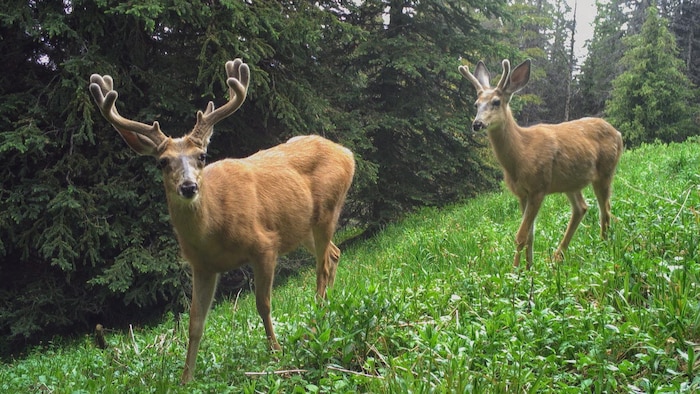Open in full screen mode The researchers used the images from 5000 camera traps located in many countries to study the activity of 163 species of mammals. Here, mule deer. (Archive photo) Speech synthesis, based on artificial intelligence, makes it possible to generate spoken text from written text . A global study involving researchers at the University of British Columbia (UBC) shows that COVID-19 pandemic lockdowns COVID-19 has not affected animal species in the same way. The study (in English) was published (New window) in the scientific journal Nature Ecology and Evolution. More than 220 researchers from around the world participated, using 5,000 camera traps across the globe. They were able to observe the behavior of more than 163 species of mammals during the confinement periods imposed during the COVID-19 pandemic. Large herbivores, like deer or moose, tend to become more active when humans are present, the researchers conclude. It's the same for raccoons, for example. These may become more active around humans, as they become accustomed to their presence and find food, such as trash or plants, that they can access at night. On the other hand, carnivorous animals, such as wolves or wolverines, tend, on the contrary, to be less active when humans encroach on their territory, preferring to avoid meetings. The study's findings run counter to what Dr. Cole Burton, associate professor of forest resource management at the University of British Columbia (UBC) and Canada Research Chair in the conservation of land mammals, names popular stories. Loading ELSEWHERE ON INFO: Violence in Haiti: Ottawa launches evacuation operationLoading in progress ELSEWHERE ON NEWS: Violence in Haiti: Ottawa launches evacuation operation The received idea is that animals have taken over sites that humans cannot could no longer attend. The study shows that it’s actually much more nuanced than that. There was no reaction common to all species, analyzes Marco Festa-Bianchet, professor of ecology and director of the Department of Biology at the University of Sherbrooke. During the pandemic, we saw some crazy reports, remembers Marco Festa-Bianchet. In England, images of goats in a village had been filmed. The goats were presented as wild, except that they were actually domesticated. Dolphins were supposedly seen in the canals of Venice, but the footage was filmed in India.
Violence in Haiti: Ottawa launches evacuation operation
Violence in Haiti: Ottawa launches evacuation operation
Lockdowns gave researchers a unique opportunity to study animal behavior when human movement was different. (Archive photo)
For Kaitlyn Gaynor, co-author of the study and biologist at UBC, the results of this research highlight the importance of measures to minimize the harmful effects that humans can have on wildlife.
In remote areas where human presence is limited, the effects of our presence on wildlife can be particularly significant, she explains.
To give wild animals the space they need, we can consider setting aside protected areas or movement corridors free from any human activity. We could also consider seasonal restrictions, such as the temporary closure of campsites or hiking trails during migration or breeding seasons, adds the scientist.
Mobility restrictions imposed by COVID-19 have given researchers a unique opportunity to study how animals respond when the number of people sharing their habitat changes radically in a relatively short period of time, says Dr. Cole Burton.
If certain areas were deserted by humans because traffic was prohibited there , others, on the contrary, saw their attendance explode during the restrictions because they were the only ones authorized. (Archive photo)
The study was not only interested in places deserted by humans because of confinements. Certain sectors, where the movement of people was authorized, have, on the contrary, seen their attendance explode.
Marco Festa-Bianchet also welcomes the technique used in this study to collect the data: Research of this magnitude which uses so many camera traps is very new.
The professor is not surprised, however. The popularity of these devices is growing. They offer interesting information, especially regarding animals that tend to flee human activities. The camera provides images of a small area, but when there are thousands of them over long periods of time, the data can be analyzed to show a trend.
According to the researcher, camera traps also make it possible to study a subject on a very large scale, across several countries. In this case, the sample is very large. This helps prevent false impressions from reduced data.
- Simon Jousset (View profile)Simon JoussetFollow

